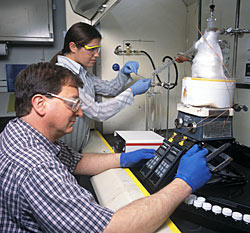
NIST chemists Thomas Bruno and Beverly Smith analyze complex fuel mixtures with the new advanced distillation curve apparatus.
Researchers at the National Institute of Standards and Technology (NIST) have developed an improved method for measuring basic properties of complex fuel mixtures like gasoline or jet fuel. The new apparatus for measuring distillation properties produces significantly more detailed and accurate data needed to better understand each fuel and its sample-to-sample variation. The data are valuable in tailoring fuels for high-performance and low emissions, and in designing new fuels, engines and emission controls.
Petroleum-based fuels, with few exceptions, are highly complex mixtures of hundreds of distinct components from light butanes to increasingly heavy oils. For decades, distillation curves have been one of the most widely accepted ways of characterizing a fuel. The curve charts the percentage of the total mixture that has evaporated as the temperature of a sample is slowly heated. The curve holds a wealth of information—not just the basic makeup of the fuel, but also indicators as to how it will perform. Engine starting ability, fuel system icing, vapor lock, fuel injection scheduling, fuel auto-ignition, hot- and cold-weather performance, and exhaust emissions all have been correlated with features of the distillation curve. The data are important both for quality control at refineries and the design of specialty high-performance fuels.
For all its utility, there are serious problems with the common method for measuring a distillation curve in industry, based on an old ASTM standard called D-86. The method is subject to large uncertainties and systematic errors that make it difficult or impossible to relate the test results to thermodynamic theory used in developing modern fuels and engines. NIST researchers added an additional temperature sensor and made other modifications, decreasing the random uncertainty in the temperature measurement and control from a few degrees to 0.05 degree and eliminating a number of systematic errors. They also added the capability to do a composition analysis of each boiling "fraction," which can provide vital insights into fuel behavior and pinpoint batch-to-batch differences to help diagnose production problems.
Details of the new fuel distillation apparatus and methodology are in two papers: T.J. Bruno. Improvements in the measurement of distillation curves. 1. A composition-explicit approach. http://pubs.acs.org/cgi-bin/abstract.cgi/iecred/asap/abs/ie051393j.html and T.J. Bruno and B.L. Smith. Improvements in the measurement of distillation curves. 2. Application to aerospace/aviation fuels RP-1 and S-8. http://pubs.acs.org/cgi-bin/abstract.cgi/iecred/asap/abs/ie051394b.html Industrial & Engineering Chemistry Research, Articles ASAP. Web Release Date: May 10, 2006.

